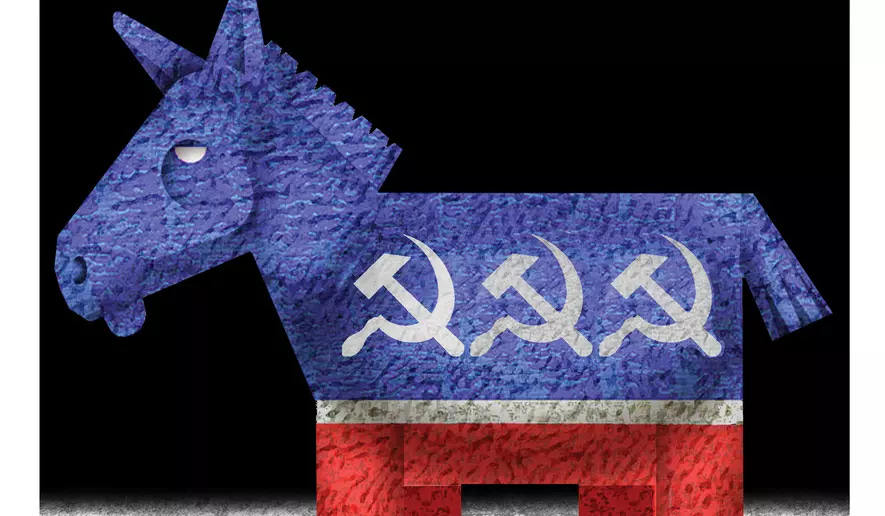The current polarization and radicalization within the Democratic Party can be understood through historical precedents in other political movements that have seen similar ideological shifts, beyond Bolshevism alone. Parallels can be drawn from periods in Western history where liberal or reformist movements adopted rigid ideological positions, centralized power, and prioritized emotional appeals over nuanced debate. Exploring these cases may clarify why the Democratic Party, like these movements, has tended towards ideological consolidation and centralization, often at the expense of broad coalition-building or institutional norms.
For instance, comparisons can be drawn to the French Revolution, particularly during the Jacobin period, where initial aims of equality, liberty, and fraternity evolved into a much more radical agenda. The Jacobins, much like the Bolsheviks later, aggressively pushed for ideological purity and rapidly centralized control, silencing or executing moderates who resisted revolutionary fervor. Though the Democrats in the United States operate within a vastly different context, this historical analogy is instructive because it highlights how radicalized factions within a broader movement may seek to outpace moderate or reformist wings, pushing a party or movement toward extreme policy goals.
The Democratic Party’s emphasis on ideological purity and orthodoxy among its progressive factions bears resemblance not only to Leninist ideologies but also to the Maoist insistence on constant ideological vigilance, such as in the Cultural Revolution. In these instances, the purging of ideological dissenters was seen as essential to achieving revolutionary goals. Although this is far from a direct parallel, the tendency within parts of the Democratic Party to enforce strict ideological boundaries on issues of identity, economic equity, and environmental policies reflects a modern variant of the struggle for ideological conformity seen in socialist regimes. This ideological policing, often enforced through social and media channels, serves as a form of non-governmental suppression of dissent that discourages a plurality of ideas within the party.
From an institutional perspective, structural shifts within the Democratic Party contribute to centralization tendencies that have raised concerns over diminishing intra-party democracy. One key factor is the increasingly dominant role of well-funded political action committees (PACs) and mega-donors, who hold sway over party leadership and candidates, sometimes leading to a top-down approach in selecting and endorsing candidates. Moreover, progressive caucuses and influence from activist organizations have pressured the Democratic National Committee (DNC) to adopt more radical platforms, often bypassing moderate voices. This centralization is compounded by the influence of high-profile progressive politicians and media figures, who frequently serve as gatekeepers for acceptable political discourse, effectively sidelining moderates without outright banning them.
The Democratic Party’s approach to constitutional norms mirrors this power concentration, as progressive advocates occasionally call for reinterpreting or even circumventing traditional constitutional frameworks to advance policy aims. Though these are generally legal mechanisms—such as advocating for Supreme Court expansion, altering the Electoral College, or using executive orders to sidestep congressional gridlock—they suggest a willingness to reinterpret long-standing structures. Historically, this bears some resemblance to the New Deal era, where FDR’s administration tested the bounds of executive authority in times of economic crisis. Yet, where FDR was reacting to a unique economic catastrophe, modern efforts appear driven by ideological goals, even in the absence of comparable national emergencies.
The Democratic Party’s ideological trajectory does not suggest a full equivalence to Bolshevism or other revolutionary movements. Rather, the blend of ideological commitment, the drive toward centralization, and a willingness to test institutional boundaries marks a departure from traditional Democratic coalition politics. This transformation warrants scrutiny from historians and political analysts alike, as it signals a shift toward a more consolidated and ideologically rigorous approach within one of America’s two major political parties.
The claim that the Democratic Party shows a trend toward "suppression of dissent" within its ranks invites scrutiny through the lens of recent political events and cultural shifts. While the party has traditionally been a broad coalition of moderates, liberals, and progressives, increasingly vocal factions, especially within progressive circles, have influenced party orthodoxy. Certain positions have come to represent ideological "litmus tests" on issues ranging from identity politics to climate policy. For instance, moderate Democrats who have raised questions about ambitious policies like "Medicare for All" or "Defund the Police" have often faced intense public and online criticism from party activists, illustrating a culture where deviations from dominant narratives may attract backlash. Although the Democratic Party has not institutionalized suppression through formal means as Bolshevism did with its secret police and surveillance apparatus, informal mechanisms such as social media-driven ostracism, public shaming, and pressures from advocacy groups discourage open debate on sensitive issues. This phenomenon raises concerns about the party’s tolerance for internal dissent and its implications for democratic values like free expression and diverse perspectives.
The comparison between the Democratic Party's approach to political power and the Bolshevik centralization under Lenin highlights both useful insights and critical differences. Bolshevism, born out of revolutionary fervor, operated in a context of civil war, widespread repression, and the goal of establishing a socialist state. This led to extreme centralization of power under a single-party system, with the dismantling of all political opposition and independent institutions. The Democratic Party, in contrast, operates within a stable, multi-party democratic system that is legally bound to constitutional checks and balances. Nonetheless, some analogies exist in how modern factions within the Democratic Party—driven by ideological cohesion—have sought to streamline decision-making. High-profile figures and influential party donors often shape policy direction, reducing the influence of rank-and-file voices. Calls to reform institutions like the Supreme Court or alter electoral mechanisms reflect a willingness to reconsider traditional power structures. However, these actions fall within constitutional limits and diverge significantly from the outright authoritarian control exercised by Bolshevik leaders. Thus, while the comparison highlights a drive for ideological uniformity, it downplays the crucial democratic norms and checks that persist in the American context.
The Democratic Party’s polarization and radicalization can be further contextualized by examining parallels with movements such as the mid-20th-century Labour Party in Britain and the U.S. Democratic Party during the 1960s civil rights era. Both periods saw factions within these parties pushing for radical shifts in policy and ideology, particularly around social welfare and civil rights. In the British Labour Party, internal divisions over socialism and nuclear disarmament led to periods of intense factionalism, while in the U.S., Democrats saw the rise of liberal and progressive elements advocating for sweeping changes in civil rights and poverty reduction. The Democratic Party’s current polarization, therefore, is not unprecedented but fits into a historical pattern where reformist factions push for expansive policies that challenge the status quo. Studying these historical movements reveals a cyclical nature of polarization, often arising when societal challenges prompt calls for systemic change. This comparison underscores that the Democratic Party’s current trajectory, while significant, follows an established pattern of ideological fervor seen in response to periods of societal transformation.
In political discourse, the use of emotional appeals has long been a powerful rhetorical tool, and the Democratic Party, like many political organizations, has increasingly relied on such appeals to rally support and energize its base. For instance, framing policy issues in terms of racial justice, environmental catastrophe, or existential threats to democracy can serve to create an emotionally charged narrative that resonates strongly with voters. While effective in mobilizing supporters, this approach risks oversimplifying complex issues and may contribute to increased polarization by casting opponents as morally deficient rather than ideologically different. Ethically, the reliance on emotional appeals raises questions about informed consent in democratic decision-making, as appeals to fear or anger may cloud rational judgment and reduce the space for nuanced debate. In a broader sense, emotional appeals are not unique to the Democratic Party; both major U.S. parties utilize these tactics. However, as emotional rhetoric intensifies, there is a risk of reducing the quality of democratic discourse by prioritizing emotional resonance over substantive policy analysis.
The argument that certain factions within the Democratic Party display a "disregard for constitutional limits" is partially supported by recent political maneuvers, though this remains an area of debate. Progressive advocates have proposed structural reforms, such as expanding the Supreme Court, abolishing the Electoral College, and pushing executive actions to bypass legislative gridlock. These proposals often arise from a desire to overcome entrenched institutional roadblocks that progressives view as hindering popular democratic mandates. However, critics argue that these strategies reflect a willingness to bypass traditional constitutional safeguards, which could set precedents that erode the durability of democratic institutions. For instance, the push for "court-packing" could undermine judicial independence, while expanding executive actions may circumvent legislative accountability. Such measures might provide short-term policy wins, but the longer-term implications could be destabilizing, setting a precedent for future administrations to erode checks and balances when convenient. These trends call for careful consideration of constitutional principles, as efforts to circumvent established norms may lead to a more fragile and contentious democratic system over time.
In sum, while the Democratic Party’s recent ideological shifts and centralizing tendencies bear some superficial resemblance to historical revolutionary movements, the context, degree, and mechanisms involved differ significantly. Its trajectory can be better understood through comparisons with reformist movements within Western democratic frameworks, offering insights into the cyclical nature of political polarization and the complexities of ideological shifts within a pluralistic system. The ethical implications of emotional appeals and potential risks associated with pushing constitutional limits highlight the importance of maintaining democratic principles amidst pressures for rapid change, emphasizing the need for vigilance in preserving democratic institutions in pursuit of ideological goals.
Briefing Doc: The Democratic Party's Ideological Shift - A Historical Perspective
This document reviews the main themes and key points emerging from the provided sources, analyzing claims of the Democratic Party's recent polarization and radicalization within a historical context. While the sources draw parallels to Bolshevism, further exploration suggests more nuanced comparisons with reformist movements in Western democracies.
Key Themes:
Polarization and Radicalization: The sources argue that the Democratic Party, particularly its progressive wing, has undergone significant polarization and radicalization in recent decades. This is evidenced by:
A shift towards progressive ideology with the adoption of more radical policy positions and rhetoric.
The rise of "ideological purity tests" and increased pressure to conform to specific narratives on issues like identity politics and climate change.
The silencing or marginalization of moderate voices within the party through social media and public pressure.
Centralization of Power: The sources point to a growing concentration of power within the party, marked by:
The increasing influence of PACs and mega-donors, potentially leading to a top-down approach in candidate selection and policy direction.
The pressure from progressive caucuses and activist groups on the DNC to adopt more radical platforms.
The emergence of high-profile progressive politicians and media figures who act as gatekeepers for acceptable political discourse.
Disregard for Constitutional Limits: Concerns are raised about the willingness of some progressive advocates to:
Reinterpret or circumvent traditional constitutional frameworks to advance their policy goals.
Advocate for structural reforms like expanding the Supreme Court or abolishing the Electoral College.
Increase the use of executive actions to bypass legislative gridlock.
Historical Parallels:
While the sources initially compare the Democratic Party's trajectory to Bolshevism, further analysis suggests more appropriate comparisons with other historical movements, including:
The French Revolution (Jacobin Period): Similarities are drawn to the Jacobins' aggressive push for ideological purity and rapid centralization of power, silencing or executing those who resisted the revolutionary fervor. "[T]his historical analogy is instructive because it highlights how radicalized factions within a broader movement may seek to outpace moderate or reformist wings, pushing a party or movement toward extreme policy goals."
Maoist China (Cultural Revolution): The emphasis on ideological purity within the Democratic Party is likened to the Maoist insistence on constant ideological vigilance and purging of dissenters. The sources point to the modern equivalent in the form of "ideological policing" through social and media channels, discouraging a plurality of ideas within the party.
Mid-20th Century British Labour Party and 1960s US Democratic Party: Parallels are drawn to periods of intense factionalism and the rise of progressive elements pushing for radical policy shifts in social welfare and civil rights. This underscores a cyclical pattern of polarization arising in response to calls for systemic change during periods of societal transformation.
Potential Consequences:
The sources express concern about the potential consequences of the Democratic Party's perceived shift, including:
Erosion of Democratic Values: The increasing intolerance for dissenting views and the use of social pressure to enforce ideological conformity could stifle open debate and diverse perspectives, undermining core democratic principles.
Weakening of Institutions: Efforts to circumvent established constitutional norms and push for structural reforms could erode the checks and balances that safeguard democratic institutions, potentially destabilizing the political system in the long term.
Heightened Polarization and Gridlock: The emphasis on ideological purity and the unwillingness to compromise could further exacerbate political polarization and gridlock, hindering effective governance and problem-solving.
Key Quotes:
"The Democratic Party’s emphasis on ideological purity and orthodoxy among its progressive factions bears resemblance not only to Leninist ideologies but also to the Maoist insistence on constant ideological vigilance."
"Although the Democratic Party has not institutionalized suppression through formal means as Bolshevism did… informal mechanisms such as social media-driven ostracism, public shaming, and pressures from advocacy groups discourage open debate on sensitive issues."
"This centralization is compounded by the influence of high-profile progressive politicians and media figures, who frequently serve as gatekeepers for acceptable political discourse, effectively sidelining moderates without outright banning them."
Conclusion:
While the Democratic Party's recent ideological shifts and centralizing tendencies raise concerns about its impact on democratic norms and institutions, it is crucial to avoid simplistic comparisons to revolutionary movements like Bolshevism. Historical analysis suggests a more nuanced understanding through parallels with reformist movements in Western democracies. The ethical implications of emotional appeals and potential risks associated with circumventing constitutional limits highlight the need for ongoing scrutiny and vigilance in preserving democratic principles amidst pressures for rapid change.















Share this post